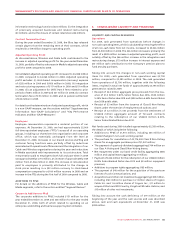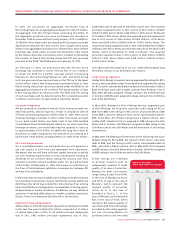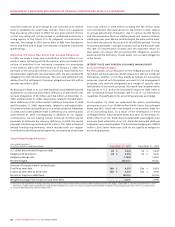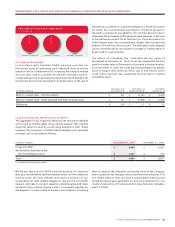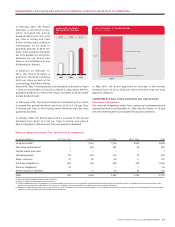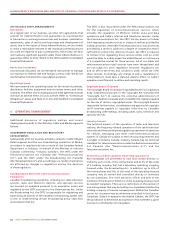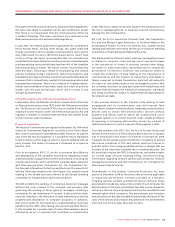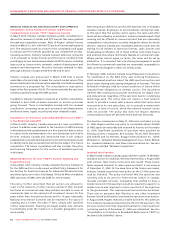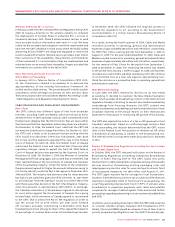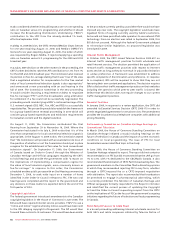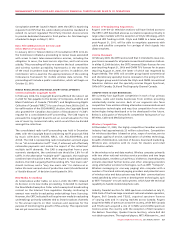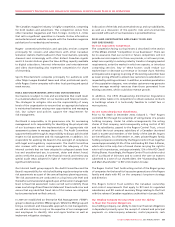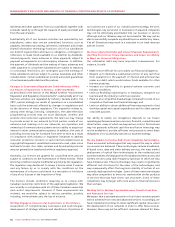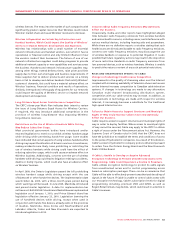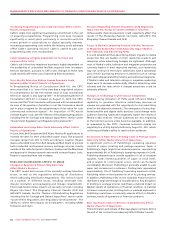Rogers 2009 Annual Report Download - page 51
Download and view the complete annual report
Please find page 51 of the 2009 Rogers annual report below. You can navigate through the pages in the report by either clicking on the pages listed below, or by using the keyword search tool below to find specific information within the annual report.
ROGERS COMMUNICATIONS INC. 2009 ANNUAL REPORT 55
MANAGEMENT’S DISCUSSION AND ANALYSIS OF FINANCIAL CONDITION AND RESULTS OF OPERATIONS
Wireless Enhanced E9-1-1 Service
In February 2009, the CRTC released Telecom Regulatory Policy CRTC
2009-40 issuing a directive to the wireless industry to complete
the deployment of wireless Phase II enhanced E9-1-1 service in
Canada by February 2010. Phase II allows wireless carriers to send
more accurate location information with each 9-1-1 call. We have
rolled out the necessary technologies to meet this requirement and
have met the CRTC deadline in those areas where the Public Safety
Answering Points (“PSAP”) are ready and equipped to receive the
location-based information. Wireless service providers must inform
their customers of the availability, characteristics and limitations
of their enhanced 9-1-1 services before they are implemented, and
reiterate them on an annual basis thereafter. Rogers provided this
information on customer bills in the fall of 2009.
Basic Telecommunications Services and
Other Matters Proceeding
In January 2010 in Telecom Notice of Consultation CRTC 2010-
43, the Commission initiated a proceeding to re-examine the
appropriateness of the existing forbearance framework for
mobile wireless data services. The proceeding will include a public
consultation, which will begin on October 25, 2010. See also “Basic
Telecommunications Services and Other Matters Proceeding” under
“Cable Regulation and Regulatory Developments” below.
CABLE REGULATION AND REGULATORY DEVELOPMENTS
Part II Fees
The CRTC collects two different types of fees from broadcast
licencees, including Cable and Media, which are known as Part I
and Part II fees. In 2003 and 2004, lawsuits were commenced in the
Federal Court alleging that the Part II licence fees are taxes rather
than fees and that the regulations authorizing them are unlawful.
On December 14, 2006, the Federal Court ruled that the CRTC did
not have the jurisdiction to charge Part II fees. On October 15, 2007,
the CRTC sent a letter to all broadcast licencees stating that the
CRTC would not collect Part II fees due in November, 2007. Both
the Crown and the applicants appealed this case to the Federal
Court of Appeal. On April 28, 2008, the Federal Court of Appeal
overturned the Federal Court and ruled that Part II fees are valid
regulatory charges. Leave to appeal the April 28, 2008 Federal
Court of Appeal decision was granted by the Supreme Court on
December 18, 2008. On October 7, 2009, the Minister of Canadian
Heritage and Official Languages, announced that a settlement had
been reached between the Government of Canada and members
of the broadcasting industry. Under the terms of the settlement,
the government agreed to forgive the amounts otherwise owing to
it from the industry under the Part II fee regime in November 2007,
2008 and 2009. The industry had been accruing for these amounts
but had not yet paid them given the CRTC’s October 15, 2007 letter
to all broadcast licencees stating it would not collect these fees
until there was a final decision in the Part II fee litigation. Industry-
wide, this amounts to approximately $450 million. In exchange,
the Canadian Association of Broadcasters agreed to discontinue
its court action against the Government of Canada. On a going
forward basis, the Government of Canada agreed to recommend
to the CRTC that it amend the Part II fee regulation in order to
cap the annual fee at $100 million per year (with indexed
CPI increases annually) commencing in November 2010. Each
broadcasting licencee will pay its share of the capped fee based on
its percentage of revenue share across all broadcasting licencees.
In December 2009, the CRTC initiated the required process to
amend the regulation to act according to the Government’s
recommendation in a timely manner (Broadcasting Notice of
Consultation 2009-797).
As a result, during the fourth quarter of 2009, Cable and Media
recorded recoveries in operating, general and administrative
expenses of approximately $60 million and $19 million, respectively,
for CRTC Part II fees covering periods from September 1, 2006 to
August 31, 2009. For the year ended December 31, 2009, Cable and
Media recorded recoveries in operating, general and administrative
expenses of approximately $46 million and $15 million, respectively,
for the reversal of Part II fees for the period from September 1,
2006 to December 31, 2008. The remaining $18 million was related
to the period from January 1, 2009 to August 31, 2009, and has been
recorded as a credit within adjusted operating profit. We continue
to record these fees at a new rate equal to approximately two-
thirds the old rate on a prospective basis in operating, general and
administrative expenses.
New Media Proceeding
In June 2009, the CRTC released its decision on its new media
proceeding. It decided to maintain the New Media Exemption
Order which exempts all broadcasting content on the Internet from
regulation thereby continuing to exempt new media broadcasting
undertakings from licencing. However, the CRTC ordered new
media broadcasting undertakings (primarily websites tied to linear
broadcast channels) to file annual reports on their revenues and
expenses for the purpose of monitoring the growth of this activity.
The CRTC also rejected the notion of a tax on ISP revenues to fund
Canadian ‘webisodes’. Based on conflicting legal opinions filed
in the proceeding, the decision determined that the CRTC would
refer to the Federal Court the question of whether an ISP, when
it distributes broadcasting, is subject to the Broadcasting Act.
The referral to the Court has been made and a decision is expected
in 2010.
Review of Broadcasting Regulations including Fee-for-Carriage
and Distant Signal Fees
In October 2008, the CRTC released its Decision on the Review of
Broadcasting Regulations proceeding initiated by Broadcasting
Notice of Public Hearing 2007-10. The CRTC issued new policy
frameworks for cable and satellite companies and pay and specialty
services aimed at streamlining existing packaging rules and
relaxing genre protection rules for news and sports services. Most
of its proposed changes do not take effect until August 31, 2011.
The CRTC again rejected fee-for-carriage for local broadcasters.
However, it decided to levy a new 1% tax on cable and DTH revenues
(starting in September 2009) to fund local TV programming, the
Local Programming Improvement Fund (“LPIF”). It will also allow
broadcasters to negotiate payments with cable and satellite
companies for carriage of distant signals. It also announced further
proceedings regarding advertising on local commercial availabilities
and VOD.
In a follow-up proceeding in late April, 2009, the CRTC held a hearing
to consider whether private Canadian OTA Broadcasters (CTV,
Global, Citytv and OMNI) should be relieved of any of their local or
priority programming obligations over the 2009/10 broadcast year.


